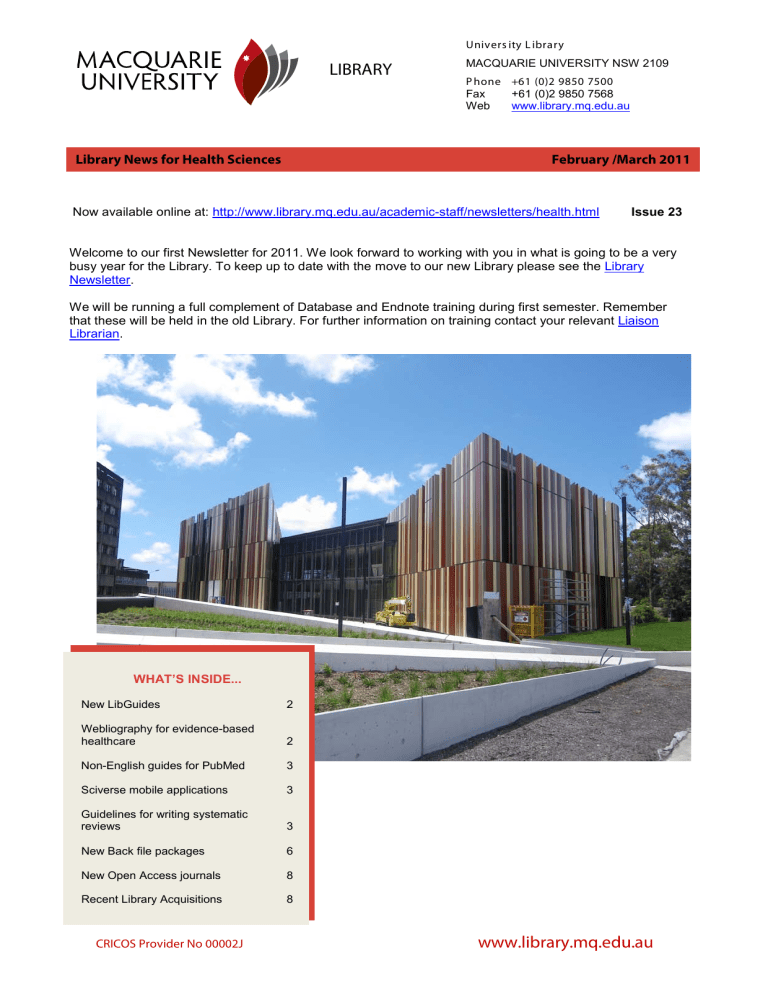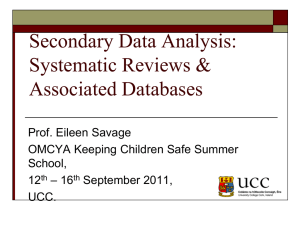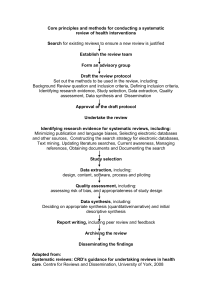Liaison Librarians - Library

LIBRARY
Univers ity L ibrary
MACQUARIE UNIVERSITY NSW 2109
P hone +61 (0)2 9850 7500
Fax +61 (0)2 9850 7568
Web www.library.mq.edu.au
Library News for Health Sciences February /March 2011
Now available online at: http://www.library.mq.edu.au/academic-staff/newsletters/health.html
Issue 23
Welcome to our first Newsletter for 2011. We look forward to working with you in what is going to be a very busy year for the Library. To keep up to date with the move to our new Library please see the Library
Newsletter .
We will be running a full complement of Database and Endnote training during first semester. Remember that these will be held in the old Library. For further information on training contact your relevant Liaison
Librarian .
WHAT’S INSIDE...
WHAT’S INSIDE...
Consumer Health 2
Webliography for evidence-based
New: Bibliometrics
2
Webcasts 3
Non-English guides for PubMed 3
3 reviews
resource 4
Guidelines for writing systematic
SAGE Research
3
5
New Open Access journals 8
J l
8
5
CRICOS Provider No 00002J
www.library.mq.edu.au
LIBRARY Library News for Health Sciences February /March 2011
New LibGuides
Bibliograhic Referencing Software : - http://libguides.mq.edu.au/referencing-software
Macquarie University has a licence for two bibliographic management software packages:
•
EndNote – you will need to refer to the LibGuide to download EndNote to your computer.
•
RefWorks
This LibGuide provides information about both these applications as well as free software such as BibTex ,
Mendeley , and Zotero.
Look at the information given for each product, particularly note any information under Issues and
Technical information that may pertain to your situation. Check information under the software description and then look at the support guides for specific products before deciding on the software you wish to use.
Bibliometrics : - http://libguides.mq.edu.au/bibliometrics
Bibliometrics is the statistical analysis of texts and information. In a research environment a common example of bibliometrics is the use of citation analysis to determine how many times a researcher's work has been cited in key literature.
This LibGuide compares citation databases, has information on evaluating journals, institutional rankings and covers the ERA Rankings.
Please have a look at both these LibGuides and forward any feedback.
Webliography for evidence-based health care
The Webliography within the Cochrane Collaboration presents an overview of the most important print and online resources for evidence-based health care and medicine. The recommendations for books, articles and online resources are browseable by speciality, such as epidemiology, statistics, literature appraisal, reporting guidelines, and more. The other resources, such as databases and journals, are listed alphabetically. See the following link for more information. http://www.cochrane.org/about-us/evidence-based-health-care/webliography
- 2 -
LIBRARY
Non-English guides for PubMed
Library News for Health Sciences February /March 2011
For those of you whose first language is not English the National Library of Medicine in the US has produced non-English guides for PubMed .
The guides are available in the following languages:
Chinese / 中文
French / Français
German / Deutsch
Italian / Italiano
Japanese / 日本語
Norwegian / Norsk
Portuguese / Português
Russian / Русский
Spanish / Español
Vietnamese / Ti ếng Việt
To find these guides please go to: http://nnlm.gov/training/resources/intlpubmedlinks.html
Sciverse Mobile Applications – access research from your iPhone
SciVerse Mobile Applications are apps to help you research where you are and where you need to be.
These mobile apps help you gain access to the latest abstracts, articles and books from two of the most recognised and trusted databases, SciVerse Scopus and SciVerse ScienceDirect . For online users of
Macquarie University Library, the respective apps are free. You can download them from the following page: http://info.sciverse.com/sciverse-mobile-applications
Guidelines for writing systematic reviews
We frequently receive requests for help with writing systematic reviews. Here is a summary of the steps for writing a systematic review and a reference list of Library resources.
Contact Mary ( mary.simons@mq.edu.au
) or Karen ( karen.marks@mq.edu.au
) for further assistance.
A systematic review is an overview of primary studies that use explicit and reproducible methods.
Systematic reviews apply scientific strategies that limit bias by the systematic assembly, critical appraisal and synthesis of all relevant studies on a specific topic.
A meta-analysis is a mathematical synthesis of the results of two or more primary studies that addressed the same hypothesis in the same way.
- 3 -
LIBRARY Library News for Health Sciences February /March 2011
Systematic reviews as well as meta-analyses of appropriate studies can be the best form of evidence available for health care practitioners.
SYSTEMATIC REVIEW STEPS:
1. Research Question
2. Research Protocol
3. Literature Search
4. Data Extraction
5. Quality Appraisal
6. Data Analysis and Results
7. Interpretation of Results
1. Research Question
The first step in performing a systematic review is to formulate a primary research question as part of the research protocol. Appropriate questions to be addressed include: (1) phenomena associated with disease or interventions, (2) disease or condition frequency, (3) diagnostic accuracy, (4) disease etiology and/or risk factors, (5) prognosis, and (6) intervention effects.
The aims of a systematic review can be varied and include: (1) clarifying the relative strengths and weaknesses of the literature on the question, (2) summarizing a large amount of literature, (3) resolving literature conflicts, (4) evaluating the need for a large clinical trial, (5) avoiding a redundant unnecessary trial, (6) increasing the statistical power of smaller studies, (7) improving the precision or identify a smaller treatment effect, and (8) improving the generalizability of treatment outcomes.
2. Research Protocol
Once the research question is formulated, the research protocol is developed. The goal of developing a research protocol is to develop formulation of the questions and methods of the review before retrieving the literature. The methods for literature searching, screening, data extraction, and analysis should be contained in a written document to minimize bias before starting the literature search.
3. Literature Search
Sources to search for studies for systematic reviews:
•
Cochrane Central Register of Controlled Trials (via Cochrane Library)
•
Cochrane Database of Systematic Reviews (via Cochrane Library)
•
Database of Abstracts of Reviews of Effects (DARE) database – ie: other reviews (via Cochrane
Library)
•
Medline and Embase (Library does not subscribe to Embase)
•
Other databases, eg CINAHL, Scopus, PsycINFO
•
Journals
•
Conference proceedings
•
Bibliographies and references listed in primary sources
•
Unpublished and ongoing studies, including known experts in the field (seek by personal communication)
•
Raw data from published trials (seek by personal communication)
•
Foreign language literature (do not limit searches to English)
•
“Grey literature” (theses, internal reports, non peer-reviewed journals, pharmaceutical industry files)
•
PubMed Clinical Queries ( www.ncbi.nlm.nih.gov/entrez/query ) includes search filters offering 4 categories of aetiology, prognosis, treatment, diagnosis, and choice of emphasizing sensitivity or specificity.
- 4 -
LIBRARY Library News for Health Sciences February /March 2011
•
Cochrane Handbook appendix contains a list of approximately 30 clinical trials registries for finding unpublished primary studies (See Reference List for Library call number)
A minimum of two reviewers performs a first-stage screening of titles and abstracts based on the research question and its study design, population, intervention, and outcome to be studied. Based on the initial screening, selected full-text articles are obtained for the second-stage screening. Using the full text a second-stage screening is performed by at least two reviewers. The studies selected are then submitted for data extraction.
4. Data Extraction
A standardized form (paper or electronic) assists in the task of data extraction. For example:
Sample Data Extraction Form Items:
Reference— including journal, title, author, volume in page numbers
Objective— the study objective as stated by the authors
Study design— type of trial
Population— demographics of the participants in the study
Intervention— description of the intervention
Control— description of the control group or alternative intervention
Outcome— results of the intervention and how measured including statistics used
Comments— details regarding the study quality
5. Quality Appraisal
A checklist to assess for biases is important: several quality scales and checklists have been developed for this.
Each trial should be evaluated in terms of its:
•
Methodological quality—the extent to which the design and conduct are likely to have prevented systematic errors (bias)
•
Precision—a measure of the likelihood of random errors (usually depicted as the width of the confidence interval around the result)
•
External validity—the extent to which the results are generalisable or applicable to a particular target population
6. Data Analysis and Results
After including and excluding studies based on the quality appraisal, data analysis and results of the studies should be undertaken. The initial step for this process involves a simple descriptive evaluation of each study, commonly presented in tabular format. Tables should include the population under study, the interventions, and outcomes.
7. Interpretation of Results
Most of this information can be presented in the data analysis and results table in the manuscript. The strengths and weaknesses of the included studies must be discussed. Conclusions should be based on the best available scientific evidence. Recommendations regarding future studies can also be made.
PRISMA stands for Preferred Reporting Items for Systematic Reviews and Meta-Analyses ( www.prismastatement.org
) . It is an evidence-based minimum set of items for reporting in systematic reviews and metaanalyses. PRISMA should be a helpful resource to improve reporting of systematic reviews and metaanalyses.
References used for this summary (all are available from the Library):
- 5 -
LIBRARY Library News for Health Sciences February /March 2011
Wright, R. W., R. A. Brand, et al. (2007). "How to Write a Systematic Review." Clinical Orthopaedics and
Related Research 455 : 23-29
Systematic reviews in health care a practical guide / Paul Glasziou ... [et al.]. Cambridge ; New York :
Cambridge University Press, 2001. eBook: Available via Library catalogue
Greenhalgh, T. (1997). "How to read a paper: Papers that summarise other papers (systematic reviews and meta-analyses)." BMJ 315 (7109): 672-675.
Oxman, A. D. (1994). "Systematic Reviews: Checklists for review articles." BMJ 309 (6955): 648-651.
Systematic reviews and meta-analysis /Julia H. Littell, Jacqueline Corcoran, Vijayan Pillai.
Series Title: Pocket guides to social work research methods Oxford ;New York : Oxford University Press.
Available in Library: H62 .L497 2008
Harvey, R. (2007). "Systematic review as a primer rather than endpoint for clinical research: The training perspective." Otolaryngology-Head and Neck Surgery 137 (4): S66-S68.
Moher D, Liberati A, Tetzlaff J, Altman DG, The PRISMA Group (2009). “Preferred Reporting Items for
Systematic Reviews and Meta-Analyses: The PRISMA Statement”. PLoS Med 6 (6): e1000097. doi:10.1371/journal.pmed1000097
Cochrane handbook for systematic reviews of interventions / edited by Julian P.T. Higgins Chichester,
England ; Hoboken, NJ : Wiley-Blackwell and Sally Green., c2008. Available in Library: R723.7 .C63 2008
New back file packages
The following back files are now available through the Library catalogue or Journal Finder :
Thieme
Minimally Invasive Neurosurgery: 1958 – 1999
Skull Base: 1991 – 2000
International Journal of Sports Medicine: 1980 to present
Seminars in Hearing: 1980 –1999
Taylor & Francis Sport, Leisure & Tourism Online Archive
Sports Training, Medicine and Rehabilitation: 1988-1991
Sports Medicine, Training & Rehabilitation: 1991 -1996
Research in Sports Medicine: an International Journal: 1992-1996
Journal of Sports Sciences: 1983-1996
American Medical Association Journals
Archives of Ophthalmology: 1929-1950
AMA Archives of Ophthalmology: 1950-1960
Archives of Neurology and Psychiatry: 1919-1950
AMA Archives of Neurology & Psychiatry: 1950-1959
AMA Archives of Neurology: 1959-1960
- 6 -
LIBRARY Library News for Health Sciences February /March 2011
AMA Archives of General Psychiatry: 1959-1960
Archives of Internal Medicine: 1908-1950
AMA Archives of Internal Medicine: 1950-1960
Archives of Otolaryngology: 1925-1950
AMA Archives of Otolaryngology: 1950-1960
Archives of Otolaryngology: 1960-1985
Archives of Surgery: 1920-1950
AMA Archives of Surgery: 1950-1960
Journal of the American Medical Association: 1883-1960
Springer Biomedical and Life Sciences Back File – titles include:
Journal of Neurology: 1974-1996
Human Genetics: 1976-1996
Neurological Sciences: 1980-1996
Journal of Neural Transmission: 1972-1996
Medical Microbiology and Immunology: 1971-1996
Cell and Tissue Research: 1974-1996
Investigational New Drugs: 1983-1996
Journal of Comparative Physiology A: Neuroethology, Sensory, Neural, and Behavioral Physiology: 1984-
1996
Archives of Toxicology: 1974-1996
Biomedical Engineering: 1967-1996
Brain Topography: 1988-1996
Cellular and Molecular Neurobiology: 1981-1996
Neuroscience and Behavioral Physiology: 1972-1996
Springer Behavioral Sciences Back File – titles include:
Cognitive Therapy and Research: 1977-1996
Journal of Abnormal Child Psychology: 1973-1996
Journal of Autism and Developmental Disorders: 1979-1996
Journal of Behavioural Medicine: 1978-1996
Journal of Cross-Cultural Gerontology: 1986-1996
Journal of Nonverbal Behavior: 1976-1996
Journal of Psycholinguistic Research: 1971-1996
Psychological Research: 1974-1996
Child and youth Care forum: 1971-1996
Journal of Psychopathology and Behavioral Assessment: 1985-1996
- 7 -
LIBRARY Library News for Health Sciences February /March 2011
New Open Access Journals
Herpesviridae 2010 1- http://www.herpesviridae.org/
Veterinary Research 2011 42 - http://www.veterinaryresearch.org/
Recent Library Acquisitions
Please use this link to view the latest items now available for loan.
Feedback and contributions
Please send your comments and contributions for the next Newsletter (February/March) to either Karen or
Mary. karen.marks@mq.edu.au
or mary.simons@mq.edu.au
Liaison Librarians
ASAM – Mary Simons and Karen Marks
Audiology & Speech Pathology – Karen Marks and Jo Hardy
Chiropractic – Karen Marks and Carol Walker
Institute of Human Cognition & Brain Science – John Elias and Mary Simons
Psychology – Andrew Spencer and John Elias
- 8 -






